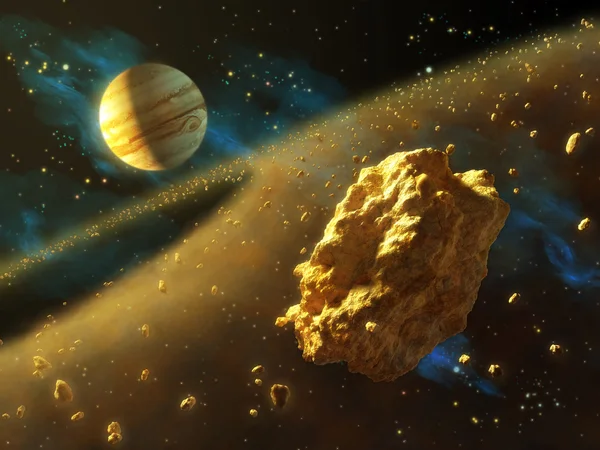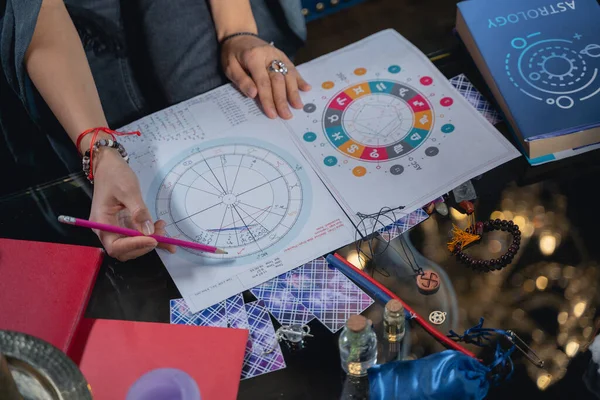Asteroids have been a topic of fascination for astronomers and astrologers alike. While astronomers study these celestial bodies for their potential impact on Earth, astrologers use them to gain a deeper understanding of an individual’s personality and life path.
In astrology, four asteroids, namely Juno, Vesta, Ceres, and Pallas, play a significant role in determining a person’s destiny.
Juno, the asteroid named after the Roman goddess of marriage, represents the energy of relationships and commitment. It is associated with long-term partnerships and signifies the qualities one seeks in a soulmate.
Vesta, on the other hand, is the asteroid of devotion and represents the energy of self-sacrifice and dedication. It is associated with the need for spiritual fulfillment and represents the qualities one seeks in a spiritual leader.
Ceres, the largest asteroid in the asteroid belt, is named after the Roman goddess of agriculture and represents the energy of nurturing and nourishment. It is associated with motherhood, fertility, and the ability to provide for oneself and others.
Pallas, named after the Greek goddess of wisdom, represents the energy of intellect and creativity. It is associated with problem-solving, strategic thinking, and artistic expression.
Understanding the role of these asteroids in astrology can provide a deeper understanding of an individual’s personality and life path.
Table of Contents
Understanding the Role of Asteroids in Astrology

Asteroids are minor celestial bodies that orbit the sun, and they are believed to have a significant impact on our lives. In astrology, asteroids are used to fill in the gaps in the natal chart, and they provide insight into different aspects of our personalities and life experiences.
The four major asteroids in astrology are Juno, Vesta, Ceres, and Pallas. These asteroids are named after ancient goddesses and are associated with specific archetypes and energies.
Juno is the asteroid of commitment and relationships. It represents the desire for partnership and the importance of balance and equality in relationships. Vesta is the asteroid of spirituality and devotion. It represents the need for inner reflection and the search for deeper meaning in life.
Ceres is the asteroid of nurturing and motherhood. It represents the nurturing qualities of the mother and the importance of caring for oneself and others. Pallas is the asteroid of wisdom and strategy. It represents the ability to think logically and make strategic decisions.
It is important to note that while these four asteroids are the most commonly used in astrology, there are many other asteroids that can also provide valuable insights into our lives.
Each asteroid has its own unique energy and symbolism, and it is up to the astrologer to determine which asteroids are most relevant to the individual’s natal chart.
In conclusion, understanding the role of asteroids in astrology can provide a deeper understanding of our personalities and experiences.
The major asteroids, Juno, Vesta, Ceres, and Pallas, each represent different aspects of our lives and can provide valuable insights into our relationships, spirituality, nurturing qualities, and decision-making abilities.
Individual Asteroids and Their Significance
Juno: The Asteroid of Marriage and Commitment
Juno is often referred to as the asteroid of marriage and commitment. It represents the traditional roles of a wife and husband in a relationship. Juno is also associated with the balance of power in a relationship and the ability to compromise.
In a natal chart, Juno can provide insight into the individual’s attitudes towards marriage and relationships.
Vesta: The Keeper of Hearth and Home
Vesta is known as the keeper of the hearth and home. It represents the importance of family, tradition, and domestic life.
Vesta is also associated with dedication, sacrifice, and service. In a natal chart, Vesta can provide insight into the individual’s relationship with their family and their ability to create a comfortable home environment.
Ceres: The Goddess of Harvest and Fertility
Ceres is the goddess of harvest and fertility. It represents the nurturing and caring qualities of a person. Ceres is also associated with the ability to provide for oneself and others. In a natal chart, Ceres can provide insight into the individual’s relationship with food, nurturing, and their ability to care for others.
Pallas Athena: The Goddess of Wisdom and Strategy
Pallas Athena is the goddess of wisdom and strategy. It represents the ability to think strategically and make wise decisions. Pallas Athena is also associated with creativity, intelligence, and problem-solving. In a natal chart, Pallas Athena can provide insight into the individual’s intellectual and creative abilities.
The four major asteroids of most importance are Ceres, Pallas, Juno, and Vesta, known as the asteroid Goddesses.
These altogether play the biggest role in our development and makeup. In astrology, the use of asteroids has become significant to a few Western astrologers yet still only a minority of astrologers use the asteroids in chart interpretation.
Asteroids and Their Place in the Birth Chart

In astrology, the birth chart, also known as the natal chart, is a map of the sky at the moment of an individual’s birth.
It is divided into twelve houses, each representing different areas of life. The placement of planets and other celestial bodies, including asteroids, in the houses of the birth chart, can provide insight into an individual’s personality, strengths, weaknesses, and life path.
Asteroids are minor celestial bodies that orbit the sun between Mars and Jupiter. In astrology, four asteroids are commonly used in chart interpretation: Juno, Vesta, Ceres, and Pallas. Each asteroid has its own unique meaning and significance in the birth chart.
Juno, named after the Roman goddess of marriage, represents relationships, particularly long-term partnerships and marriage. Its placement in the birth chart can indicate the qualities an individual seeks in a partner and the nature of their relationship.
Vesta, named after the Roman goddess of the hearth, represents devotion, dedication, and focus. Its placement in the birth chart can indicate an individual’s passions and areas of expertise.
Ceres, named after the Roman goddess of agriculture, represents nurturing, motherhood, and the need for emotional sustenance. Its placement in the birth chart can indicate an individual’s relationship with their mother, as well as their nurturing and caregiving tendencies.
Pallas, named after the Greek goddess of wisdom, represents intelligence, strategy, and problem-solving. Its placement in the birth chart can indicate an individual’s analytical abilities and approach to problem-solving.
The placement of these asteroids in the houses of the birth chart can also provide further insight into their meanings and significance.
For example, Juno in the seventh house, which represents partnerships, may indicate a strong desire for marriage and commitment, while Vesta in the tenth house, which represents career and public life, may indicate a strong dedication to one’s profession.
Overall, the use of asteroids in chart interpretation can provide a more nuanced understanding of an individual’s personality and life path. By considering the placement of these minor celestial bodies in the birth chart, astrologers can provide more detailed and accurate readings for their clients.
Interpreting Asteroids in Different Zodiac Signs
When interpreting asteroids in different zodiac signs, it is important to keep in mind the specific qualities and traits associated with each sign. Here is a brief overview of how the four major asteroids – Juno, Vesta, Ceres, and Pallas – may manifest in each of the 12 zodiac signs:
- Aries: Juno in Aries may indicate a passionate and independent partner, while Vesta in Aries may suggest a strong dedication to personal goals. Ceres in Aries may indicate a nurturing and protective parent, and Pallas in Aries may suggest a strategic and assertive approach to problem-solving.
- Taurus: Juno in Taurus may indicate a loyal and sensual partner, while Vesta in Taurus may suggest a deep connection to nature and the earth. Ceres in Taurus may indicate a love of comfort and luxury, and Pallas in Taurus may suggest a practical and methodical approach to creativity.
- Gemini: Juno in Gemini may indicate a witty and communicative partner, while Vesta in Gemini may suggest a strong focus on intellectual pursuits. Ceres in Gemini may indicate a nurturing and curious parent, and Pallas in Gemini may suggest a quick and adaptable mind.
- Cancer: Juno in Cancer may indicate a nurturing and emotional partner, while Vesta in Cancer may suggest a strong connection to family and home. Ceres in Cancer may indicate a deeply caring and protective parent, and Pallas in Cancer may suggest a strong intuition and emotional intelligence.
- Leo: Juno in Leo may indicate a dramatic and passionate partner, while Vesta in Leo may suggest a strong dedication to creative pursuits. Ceres in Leo may indicate a proud and loving parent, and Pallas in Leo may suggest a confident and inspiring approach to leadership.
- Virgo: Juno in Virgo may indicate a practical and analytical partner, while Vesta in Virgo may suggest a strong focus on health and wellness. Ceres in Virgo may indicate a nurturing and detail-oriented parent, and Pallas in Virgo may suggest a strategic and organized approach to problem-solving.
- Libra: Juno in Libra may indicate a harmonious and balanced partner, while Vesta in Libra may suggest a strong dedication to justice and fairness. Ceres in Libra may indicate a loving and diplomatic parent, and Pallas in Libra may suggest a creative and collaborative approach to problem-solving.
- Scorpio: Juno in Scorpio may indicate an intense and transformative partner, while Vesta in Scorpio may suggest a strong dedication to personal growth and transformation. Ceres in Scorpio may indicate a fiercely protective and emotionally intense parent, and Pallas in Scorpio may suggest a strategic and powerful approach to problem-solving.
- Sagittarius: Juno in Sagittarius may indicate an adventurous and philosophical partner, while Vesta in Sagittarius may suggest a strong dedication to personal freedom and exploration. Ceres in Sagittarius may indicate a nurturing and open-minded parent, and Pallas in Sagittarius may suggest a strategic and optimistic approach to problem-solving.
- Capricorn: Juno in Capricorn may indicate a responsible and ambitious partner, while Vesta in Capricorn may suggest a strong dedication to achieving goals and success. Ceres in Capricorn may indicate a practical and disciplined parent, and Pallas in Capricorn may suggest a strategic and determined approach to problem-solving.
- Aquarius: Juno in Aquarius may indicate an unconventional and independent partner, while Vesta in Aquarius may suggest a strong dedication to humanitarian causes and social justice. Ceres in Aquarius may indicate a nurturing and progressive parent, and Pallas in Aquarius may suggest a strategic and innovative approach to problem-solving.
- Pisces: Juno in Pisces may indicate a compassionate and spiritual partner, while Vesta in Pisces may suggest a strong connection to the divine and the mystical. Ceres in Pisces may indicate a nurturing and intuitive parent, and Pallas in Pisces may suggest a strategic and imaginative approach to problem-solving.
Keep in mind that these interpretations are just a starting point and that the placement of other planets and aspects in the birth chart can greatly influence how these asteroids manifest in an individual’s life.
Asteroids and Their Connection to Planets

In astrology, asteroids are minor celestial bodies that are believed to have a significant influence on a person’s personality and life path. While the planets are the primary focus of astrological analysis, asteroids are also taken into account to provide a more complete understanding of a person’s chart.
Asteroids are often associated with specific planets, and their influence is believed to be amplified or modified by the planet they are connected to.
For example, Ceres is associated with nurturing and motherhood and is often linked to the Moon. Vesta is associated with devotion and purity and is often linked to Venus.
Each asteroid is associated with a specific sign of the zodiac, and its influence is believed to be most powerful when it is in that sign. For example, Pallas is associated with strategic thinking and is most powerful when it is in the sign of Scorpio.
Juno is associated with relationships and is most powerful when it is in the sign of Libra.
Astrologers also look at the position of asteroids in a person’s chart to gain insight into their personality and life path. For example, if a person has a strong placement of Ceres in their chart, they may be nurturing and caring and may have a strong connection to their mother or maternal figure.
While the influence of asteroids may be less well-known than that of the planets, they are an important part of astrological analysis and can provide valuable insights into a person’s chart.
By looking at the connection between asteroids and planets, astrologers can gain a deeper understanding of a person’s personality, strengths, and challenges.
Asteroids in Relation to Roman and Greek Mythology
In astrology, the asteroids are named after Greek and Roman mythological figures. These asteroids are believed to embody many of the archetypes inherent in these stories.
Many of the asteroids are named after women deities in an effort to contrast the more pronounced use of male-planetary energies in our solar system.
Juno, for example, was the third asteroid to be discovered and is 9th in mass ranking. In Roman mythology, Juno is the equivalent of the Greek goddess Hera, the queen of the gods and the goddess of marriage and childbirth.
Juno was the wife of Jupiter, the king of the gods, and was known for her jealousy and vengefulness towards her husband’s many lovers.
Vesta, another asteroid, is named after the Roman goddess of the hearth and home. Vesta was a virgin goddess, and her priestesses were known as the Vestal Virgins. They were responsible for keeping the sacred fire of Vesta burning in her temple in Rome.
Ceres, the largest asteroid, is named after the Roman goddess of agriculture, grain crops, fertility, and motherly relationships.
Ceres was the mother of Proserpina (Persephone in Greek mythology), who was kidnapped by Pluto (Hades in Greek mythology) and taken to the underworld. Ceres’ grief over her daughter’s abduction is said to have caused the seasons to change.
Pallas, named after Pallas Athena, the Greek goddess of wisdom, courage, and warfare, is the second-largest asteroid.
In Greek mythology, Athena was the daughter of Zeus and was born fully grown and armored from his forehead. She was known for her strategic thinking, intelligence, and skill in battle.
Overall, the asteroids in astrology offer a unique perspective on the ancient myths and stories of the Greek and Roman cultures. By exploring the archetypes embodied in these myths, astrologers can gain a deeper understanding of the human experience and the forces that shape our lives.
The Impact of Asteroids on Personal Growth and Spirituality

Asteroids play a significant role in astrology and can provide insight into an individual’s personal growth and spirituality.
By understanding the meaning and symbolism of the four major asteroids in astrology – Juno, Vesta, Ceres, and Pallas – individuals can gain a deeper understanding of themselves and their spiritual path.
Juno, the asteroid of committed partnerships and true love, can help individuals understand their relationship patterns and what they need in a partner.
By examining the placement of Juno in their natal chart, individuals can gain insight into the qualities they seek in a partner and the challenges they may face in relationships.
Vesta, the asteroid of devotion and self-care, can help individuals understand their relationship with themselves.
By examining the placement of Vesta in their natal chart, individuals can gain insight into their self-care practices and the areas of their lives where they need to focus more on self-love and self-nurturing.
Ceres, the asteroid of motherhood and nurturing, can help individuals understand their relationship with their mother and their own nurturing abilities.
By examining the placement of Ceres in their natal chart, individuals can gain insight into their nurturing style and the areas of their lives where they need to focus more on nurturing themselves and others.
Pallas, the asteroid of wisdom and strategy, can help individuals understand their problem-solving abilities and how they approach challenges in their lives. By examining the placement of Pallas in their natal chart, individuals can gain insight into their strategic thinking and decision-making abilities.
Overall, by examining the placement of these four major asteroids in their natal chart, individuals can gain a deeper understanding of themselves and their spiritual path. This knowledge can help individuals on their journey of personal growth and self-discovery, leading to a more fulfilling and meaningful life.
The Influence of Asteroids on Character and Personality
The four asteroids, Juno, Vesta, Ceres, and Pallas, have a significant impact on character and personality in astrology. They represent different aspects of the feminine archetype and play a vital role in chart interpretation.
Juno, the asteroid of marriage and commitment, influences one’s character by promoting a sense of balance and respect in relationships. Individuals with a strong Juno placement are known for their ability to maintain healthy relationships through mutual respect and understanding.
Vesta, the asteroid of dedication and focus, influences one’s personality by promoting intellectual pursuits and a strong work ethic. Individuals with a strong Vesta placement are known for their ability to channel their energy and focus towards achieving their goals.
Ceres, the asteroid of nurturing and motherhood, influences one’s nature by promoting a sense of equality and compassion toward others. Individuals with a strong Ceres placement are known for their nurturing nature and their ability to provide emotional support to those around them.
Pallas, the asteroid of wisdom and conflict resolution, influences one’s character by promoting a sense of intellect and problem-solving skills. Individuals with a strong Pallas placement are known for their ability to approach conflicts with a rational and logical mindset, finding solutions that benefit all parties involved.
Overall, the influence of asteroids in astrology is significant and cannot be ignored. Understanding the impact of Juno, Vesta, Ceres, and Pallas on one’s character and personality can provide valuable insights into one’s strengths and weaknesses, helping individuals navigate the complexities of life with greater ease and confidence.
Understanding Centaurs and Other Minor Bodies in Astrology

In astrology, minor bodies such as centaurs and asteroids play a significant role in interpreting one’s birth chart. Centaurs are a group of celestial bodies that orbit between Jupiter and Neptune, and they are named after the mythological creatures that are half-human and half-horse.
One of the most well-known centaurs in astrology is Chiron. Discovered in 1977, Chiron is a comet nucleus that is located between Saturn and Uranus. In astrology, Chiron represents the wounded healer and is associated with the process of healing and transformation.
Another type of minor body in astrology is dwarf planets. These are celestial bodies that are smaller than traditional planets but larger than asteroids.
of the most significant dwarf planets in astrology is Ceres. Ceres is the largest object in the asteroid belt and is associated with nurturing, motherhood, and the cycles of life and death.
Asteroids are another type of minor body in astrology. The first four asteroids discovered by astronomers in the early 1800s were Ceres, Pallas, Juno, and Vesta. These asteroids are named after female deities and have rich astrological interpretations.
For example, Juno is associated with relationships and commitment, while Vesta represents dedication and focus.
Finally, Eros is a minor body in astrology that is associated with passion, desire, and sexuality. Eros is a small asteroid that orbits between Mars and Jupiter. In astrology, the placement of Eros in one’s birth chart can provide insight into their sexual desires and fantasies.
Overall, understanding the role of centaurs and other minor bodies in astrology can provide a deeper understanding of one’s birth chart and personality traits. By considering the placement of these celestial bodies in relation to the traditional planets, astrologers can gain a more nuanced understanding of an individual’s astrological profile.
Conclusion
In conclusion, the four asteroids in astrology – Juno, Vesta, Ceres, and Pallas – add depth and nuance to astrological interpretations. Each asteroid has its own unique symbolism and influences different aspects of our lives.
Juno, known as the marriage asteroid, represents the energy of commitment, partnership, and balance in relationships. Vesta, the asteroid of devotion, governs our inner flame, our ability to focus, and our dedication to a cause.
Ceres, the asteroid of nurturing, embodies the energy of motherhood, fertility, and the cycles of life and death. Pallas, the asteroid of wisdom, represents our ability to think critically, solve problems, and make decisions.
By incorporating these asteroids into astrological readings, practitioners can gain a more comprehensive understanding of their clients’ personalities, behaviors, and life paths. It is important to note that while the asteroids can offer valuable insights, they should not be relied upon exclusively in readings.
Overall, the role of asteroids in astrology is a fascinating and constantly evolving subject. As more research is conducted and interpretations are refined, astrologers will continue to uncover new layers of meaning and significance within the celestial bodies of our solar system.



